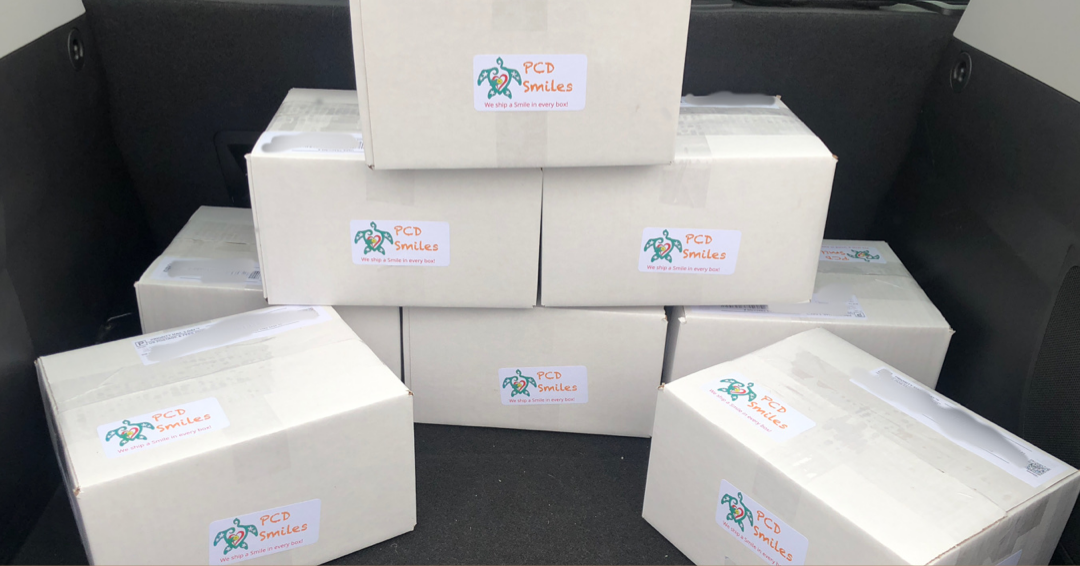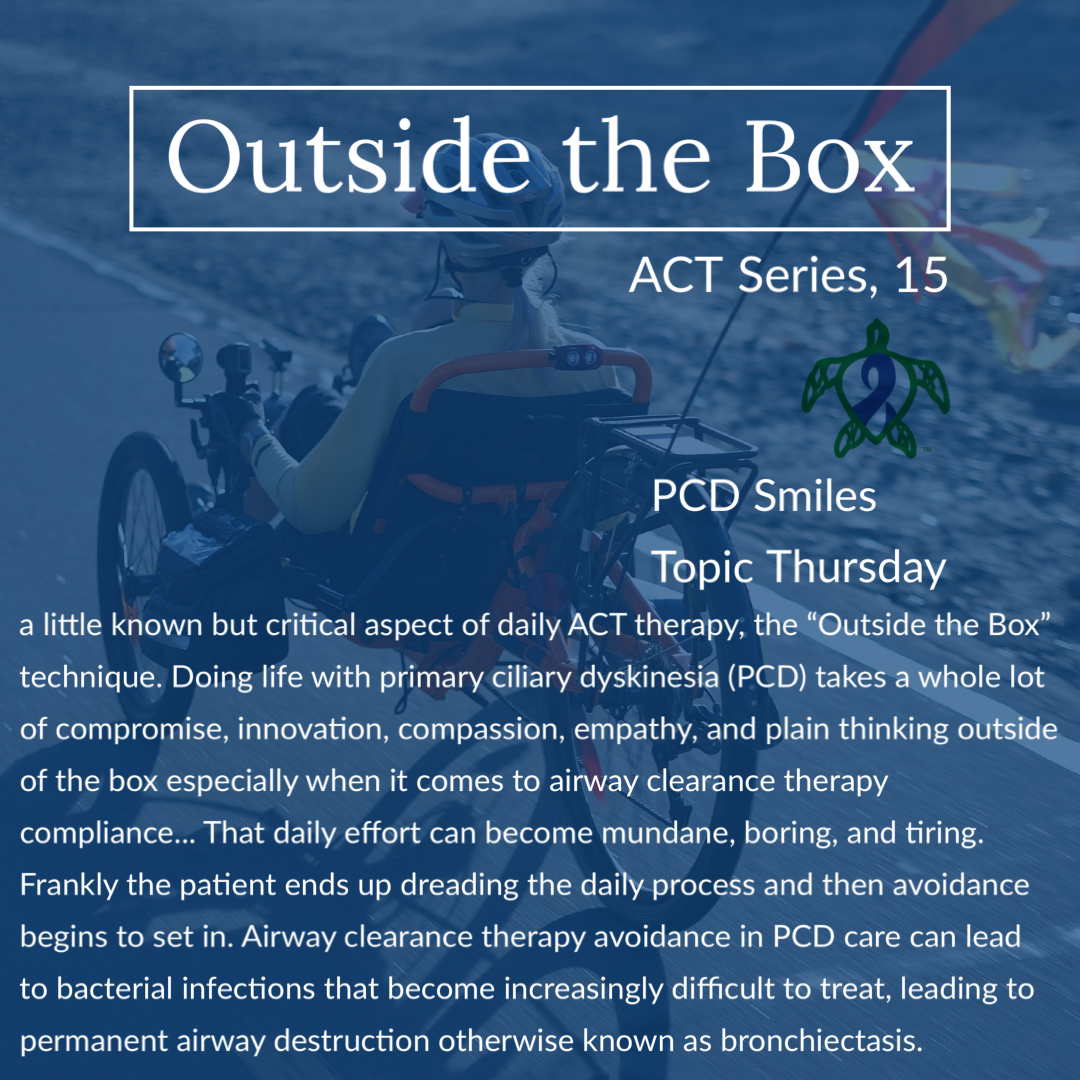The last subject in our our sixteen part series on airway clearance techniques (ACTs) is a little known but critical aspect of daily ACT therapy, the “Outside the Box” technique. Doing life with primary ciliary dyskinesia (PCD) takes a whole lot of compromise, innovation, compassion, empathy, and plain thinking outside of the box especially when it comes to airway clearance therapy compliance. When the body’s natural filter for germs, bacteria, and debris is compromised that leaves the PCD patient to have to manually clear and remove those secretions that can be removed on a daily basis. That daily effort can become mundane, boring, and tiring. Frankly the patient ends up dreading the daily process and then avoidance begins to set in. Airway clearance therapy avoidance in PCD care can lead to bacterial infections that become increasingly difficult to treat, leading to permanent airway destruction otherwise known as bronchiectasis. Bronchiectasis (BE) is a clinical consequence of having PCD, and by adulthood BE is almost universal among adult PCD patients. The goal of airway clearance therapy in PCD care is to get the patient to cough and to delay the onset of BE for as long as possible.
A recent statistic given by a leading bronchiectasis clinician-researcher, specializing in PCD patient care stated that only fifty percent of bronchiectasis patients who are prescribed airway clearance therapy actually do their airway clearance therapy. That is a staggering number of the patient population not preforming airway clearance therapy daily. Daily airway clearance therapy is critical to staving off BE for as long as possible. In PCD severe BE leads to the need for double lung transplants. There is no actual statistical data that indicates the actual number of PCD patients that have undergone lung transplants, to date, due to PCD bronchiectasis. This is thought to be because patients with bronchiectasis are often not worked up to find the underlying cause of their bronchiectasis even before their need for lung transplantation. This has hindered the ability to accurately track and record how many PCD patients have undergone lung transplants. The new PCD patient registries aim to clarify transplants in PCD, but historically we my never know the true numbers of past transplants due to PCD. Part of the outside the box theory in airway clearance therapy is helping patients to understand the true need for daily ACTs in PCD. And as discussed previously in various series articles there is little scientific evidence to support that airway clearance therapy will actually help slow or stop the pathophysiological progression of primary ciliary dyskinesia. As the true nature of PCD progression is truly unknown at this time, even by researchers. However given airway clearance therapy’s ability in other similar mucociliary clearance diseases like cystic fibrosis (CF) it is inhumane to not try and use them, according to various PCD specialists.
So what exactly is the “Outside the Box” theory in airway clearance therapy? First education is paramount. Not only patient education in airway clearance therapy, but education in PCD specifics regarding the patient’s exact overall health picture by their own medical teams. When a patient understands, truly understands on their own level, the stakes and their personal participation in their health plan this can help encourage their compliance to their own health care plan. A lot of relationship conflicts in regards to the patient care plan can be alleviated by understanding and getting the patient’s own buy in to their plan. Involving the patient and making the patient responsible for outcomes can have a huge impact on their treatment compliance. But the Outside the Box theory doesn’t end there; taking care of the mind, body, and spirt is equally important to successfully doing life with PCD.
Airway clearance therapy is arduous no matter how you look at it. It’s important for the patient to keep up their stamina by taking care of their body. Nutritious meals complete with all the food groups, including dairy and meat, is especially important in maintaining the needs of the body to preform its daily tasks like breathing. Having access to a licensed nutritionist to be sure the patient is getting the nutrition that the body needs to function can go along way in the patient’s ability and willingness to preform ACTs day in and day out. Getting adequate exercise daily can help alleviate breathlessness, and exercise also acts as a natural bronchodilator for the airways. Yes exercise helps the airways by opening them up and preventing bronchspasms while preforming ACTs, but exercise alone does not remove mucus from the airways. Even if the patient is exercising, the patient still needs to preform ACTs to cough out the mucus. Exercise alone is not a replacement for any ACT, but exercise in fact should be used in conjunction with any of the ACTs in our series. Getting adequate rest is also extremely important in alleviating breathlessness, preventing infection, and preforming airway clearance therapy. If the patient is tiring out their airway clearance therapy may not be as effective as if the patient was well rested. Tiring out while coughing and preforming ACTs can actually hinder the movement of airway mucus. Also understanding the so called “Turtle Days” is equally important in PCD airway clearance therapy. A respiratory patient’s body requires a lot of extra energy just to preform every day normal bodily functions compared to their healthy counterparts. This means respiratory patients can require lots of extra rest, especially if they are fighting of infections, healing from an infection, doing everyday normal activities, and especially if they have an extra busy schedule. It’s not unusual to have turtle days after a long stretch of abnormal or normal daily activities. These turtle days where extra rest is required should have their own airway clearance therapy plan. ACTs should not be skipped due to turtle days or tiredness, if anything it’s important to preform ACTs to prevent mucus pooling in the airways while getting extra rest.
Airway clearance therapy can have a detrimental impact on the mind and spirt. Working with a licensed therapist can help alleviate apprehension of the daily grind of airway clearance therapy. Every patient copes in different ways, healthy coping is necessary in achieving compliance with any health plan. A therapist can help a patient come up with strategies to approach and effectively preform their daily care plans. Doing life with PCD, a chronic progressive disorder can be extremely overwhelming. So overwhelming that the patient can be frozen in place and therefore can not comply with their care plan even when the patient knows the stakes. Taking care of the patient’s spirt is just as important. There are many ways to meet the spiritual needs of the patient. One of those ways is to be sure make the care plan is fun. Airway clearance therapy can get boring, and it doesn’t have to. There are many outside the box ideas to keep airway clearance therapy fresh and fun. This can be achieved by mixing ACTs up. There is no one hard and fast plan for ACTs in any disease, including PCD. When ACTs become mundane they feel more like a chore and the patient is less likely to preform their ACT. There are no rules to ACT, or rather there is no rule that says only one ACT is "THE" ACT for the patient. The last few weeks we have gone over the many options for airway clearance therapy, learning to mix it up can provide the best option for airway clearance therapy compliance. Remembering that not all airway clearance techniques have a place in the patient’s life on a day by day basis. Some patients do a different type of ACT every single time they do their therapy. During a sick plan a patient may have a designated vigorous ACT plan, and then for everyday well plans their airway clearance therapy plan may be very relaxed and fluid.
Then there is the plain fun outside the box ideas for ACTs, many can be found in the physiotherapy section of PCD Smiles’s website. Airway clearance therapy doesn’t have to be tied to a machine. But do not mistake the need to be aggressive in ACTs due to say a current lung decline or infection process as permission to avoid the machines or aggressive ACT methods during these times. Your medical care team can help you determine when is the appropriate time to exchange an aggressive ACT for something more fun like say the trampoline. There are ways to adapt a patient’s need for regular ACTs with the patient’s desire to say hike through the mountains. Ask your clinic’s licensed respiratory therapist or your clinic’s contracted respiratory therapy provider for help in finding the fun in airway clearance therapy. Remember whichever fun physiotherapy idea you decide to use or try; that you follow proper airway hygiene, including but not limited to separate devices or game pieces like straws for each participant, properly cleaning and sterilizing of equipment, utilizing coughing techniques to clear the mucus that is moved, and so on. Think outside the box, but do it with hygiene and safety for you or your PCD loved one in mind.
While airway clearance techniques are widely used throughout the world; the physiological mechanisms and consequences of airway clearance techniques are mostly misunderstood in the context of the diseases that the airway clearance techniques are prescribed for. There are many considerations for outside the box ideas. Having medical professionals that are adequately trained on the specifics of airway clearance therapy, including outside the box; is a must for patient safety, including but not limited to the prescribing physician. Airway clearance techniques are intended to remove mucus from the peripheral airways to the central airways where the mucus can coughed out by the patient in a safe manner. The process of moving the mucus along the airways to be coughed out can last for several minutes after the treatment or rather ACT session has ended. Patients can expect to have increased voluntary and involuntary airway clearance, sometimes for several hours after the ACT session has ended. ACTs provide temporary increase in mucociliary clearance, which is why multiple ACT sessions are needed daily to be effective at helping maintain pulmonary hygiene or rather effective airway clearance. We hope that you join us next week for part sixteen of our series on airway clearance techniques.
Be sure to join us next week for another Topic Thursday.
Join our Facebook group Turtle Talk Café today.
We have several ways that you can donate to PCD Smiles;
- Visit Smile E. Turtle's Amazon Wishlist
- For more information on how you can donate, please visit our "Donation" page to check out our "Do & Don't policies.
- Or sponsor a PCD Smiles cheer package today!
- To shop for your “Official” turtle care ribbon gear today, visit PCD Style or Smile E. Cove
Thank you for your consideration!
***Please speak to your respiratory therapist or your PCD medical team before commencing any new treatment. DO NOT start using a device, or technique, on this website if you have not discussed this with your PCD team first.***













